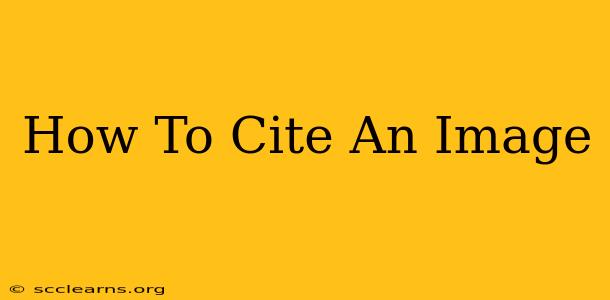Properly citing images is crucial for academic integrity and avoiding plagiarism. Whether you're writing a research paper, creating a presentation, or crafting a blog post, understanding how to cite images correctly is essential. This comprehensive guide will walk you through the process, covering different citation styles and offering practical tips.
Understanding Image Citation Basics
Before diving into specific citation styles, let's cover the fundamental elements that should always be included when citing an image:
- Author/Creator: Identify the person or organization responsible for creating the image. This might be a photographer, illustrator, or the institution that owns the image.
- Title of the Image (if available): Many images have titles, often provided by the creator or the source where you found it.
- Source/Website: Clearly state where you obtained the image. Include the URL (web address) if it's from an online source.
- Date Accessed: This is especially important for online sources, as images can be moved or deleted.
- License/Copyright Information: Always respect copyright laws. Indicate whether the image is under a Creative Commons license or another type of permission. If you're unsure, it's best to obtain explicit permission from the copyright holder.
Popular Citation Styles and How to Cite Images in Them
Different academic fields and publications prefer specific citation styles. Here are some of the most common ones and how to cite images within them:
1. MLA (Modern Language Association)
MLA style is commonly used in the humanities. Image citations within the text often follow this structure:
(Image Creator's Last Name, Year). Image Title. Source. URL (Date Accessed).
Example:
(Smith, 2023). Sunset Over the Pacific. National Geographic. https://www.nationalgeographic.com/image/sunset (Accessed October 26, 2023).
2. APA (American Psychological Association)
APA style is widely used in the social sciences. Similar to MLA, an in-text citation often includes:
(Image Creator's Last Name, Year).
A full reference entry would typically be included in a separate "References" section at the end of your work. This entry should contain more detailed information about the image source, including the URL, access date, and any license information.
Example:
(Smith, 2023).
Reference Entry:
Smith, J. (2023). Sunset Over the Pacific. National Geographic. https://www.nationalgeographic.com/image/sunset
3. Chicago/Turabian
Chicago style offers different formats depending on whether you are using notes and bibliography or author-date. In both cases, thorough information about the image source is critical. A footnote or endnote might look like this:
¹ John Smith, Sunset Over the Pacific, National Geographic, https://www.nationalgeographic.com/image/sunset (accessed October 26, 2023).
Choosing the Right Citation Style
The specific format for citing images will depend on the style guide required by your instructor, publisher, or organization. Always check the style guide's instructions carefully for the most accurate and up-to-date information.
Tips for Avoiding Plagiarism When Using Images
- Always obtain permission: If the image is not explicitly labeled for reuse (e.g., with a Creative Commons license), contact the copyright holder for permission before using it.
- Cite the source correctly: Follow the chosen citation style precisely, including all necessary information.
- Avoid simply downloading and using images: Actively search for images that are specifically designated for reuse with appropriate attribution. Websites like Unsplash, Pexels, and Pixabay often offer such images under Creative Commons licenses.
- Understand Creative Commons licenses: Familiarize yourself with different types of Creative Commons licenses to ensure you comply with their terms of use.
Conclusion
Proper image citation is not just a matter of avoiding plagiarism; it’s a demonstration of respect for intellectual property rights and scholarly rigor. By carefully following the guidelines presented in this guide and choosing the correct citation style, you can ensure that your use of images is ethical and academically sound. Remember to always double-check your citations before submitting your work.

